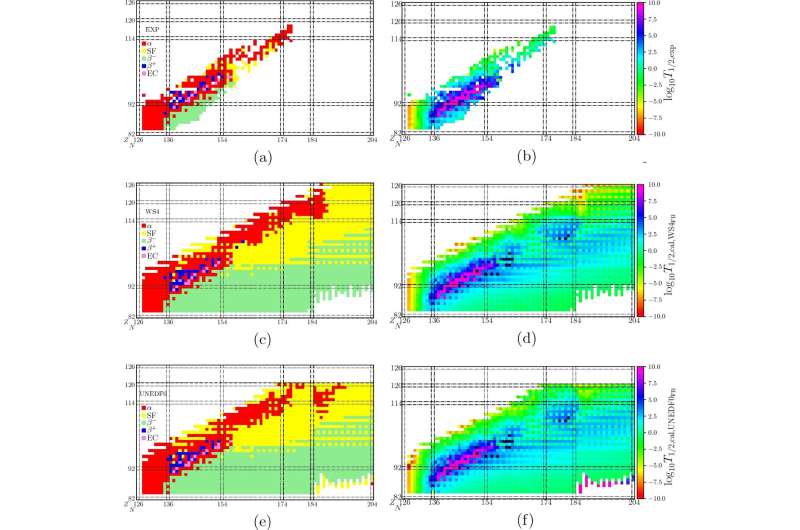The main decay modes of decay (left) and the minimum partial half-lives (right), decay, + Decay, EC and SF. (a,b) Experimental data in NUBASE2020. (cf) Results predicted by RF; WS4 and UNEDF0 indicate the source of predicted energy. Specifically, FB is used instead of decay energy to learn SF.Predict some nuclides with half-lives longer than 104 s, marked with an asterisk. Credit: Nuclear Science and Technology (2023). DOI: 10.1007/s41365-023-01354-5
In a study published in the Journal Nuclear Science and TechnologyResearchers at Sun Yat-sen University have made a major breakthrough in understanding the decay process of superheavy nuclei. Their groundbreaking research used a random forest machine learning algorithm to provide novel insights into the decay patterns and half-lives of elements other than oganethane (element 118).
In this study, the team focused on nuclei with a proton number (Z) of 84 or higher and a neutron number (N) of 128 or higher, using semi-empirical formulas to calculate the fraction of various decay modes such as α half life. Decay, β-decay, β+ decay, electron capture, and spontaneous fission (SF). The accuracy of these calculations is significantly improved through the application of the random forest algorithm, an advanced machine learning technique that integrates various nuclear properties and decay energies.
This approach led to innovative discoveries in nuclear physics, in particular the dominance of alpha decay in neutron-deficient regions and beta-decay in neutron-rich regions. The algorithm is extremely accurate, correctly predicting the main decay mode of 96.9% of the nuclei studied, and also reveals the existence of a long-lived spontaneous fission island to the southwest of the 298 Fl element (thorium), highlighting the gap between the fission barriers Complex interactions and Coulomb repulsion in superheavy elements.
This research marks a major leap forward in understanding superheavy nuclei, particularly in predicting their decay patterns. The insights gained will be crucial in exploring new elements and elusive “islands of stability” in the superheavy region. The study also highlights the importance of more accurate measurements of nuclear mass and decay energy to improve predictions. The team proposes several isotopes for future measurements that will help advance nuclear research, especially at new facilities such as CAFE2 and SHANS2 in Lanzhou.
In summary, the innovative application of the random forest algorithm opens new doors in nuclear physics, provides a more precise and comprehensive understanding of the decay process of superheavy nuclei, and paves the way for future discoveries in this exciting field.
More information:
Bo-Shuai Cai et al., Superheavy nuclear decay patterns and half-life predictions based on random forests, Nuclear Science and Technology (2023). DOI: 10.1007/s41365-023-01354-5
Provided by Chinese Academy of Sciences
citation: Artificial intelligence model predicts decay modes and half-lives of superheavy nuclei with unprecedented accuracy (December 19, 2023), Retrieved December 25, 2023, from https://phys.org/news/2023-12-ai- decay-modes-half-lives-superheavy.html
This document is protected by copyright. No part may be reproduced without written permission except in the interests of fair dealing for private study or research purposes. Content is for reference only.
#Artificial #intelligence #model #predicts #decay #modes #halflives #superheavy #nuclei #unprecedented #accuracy
Image Source : phys.org
